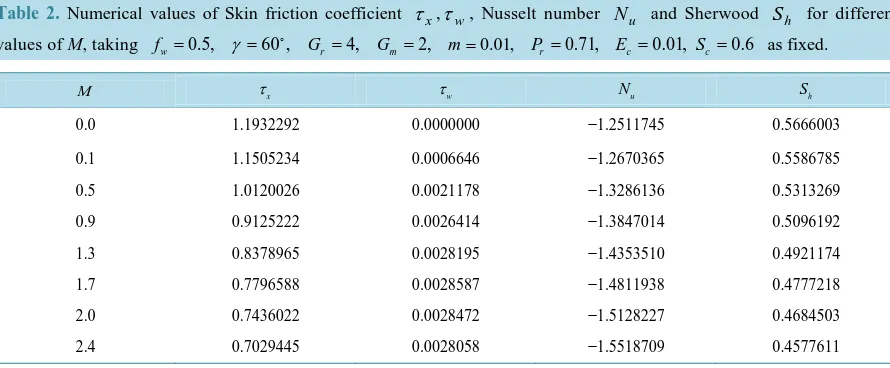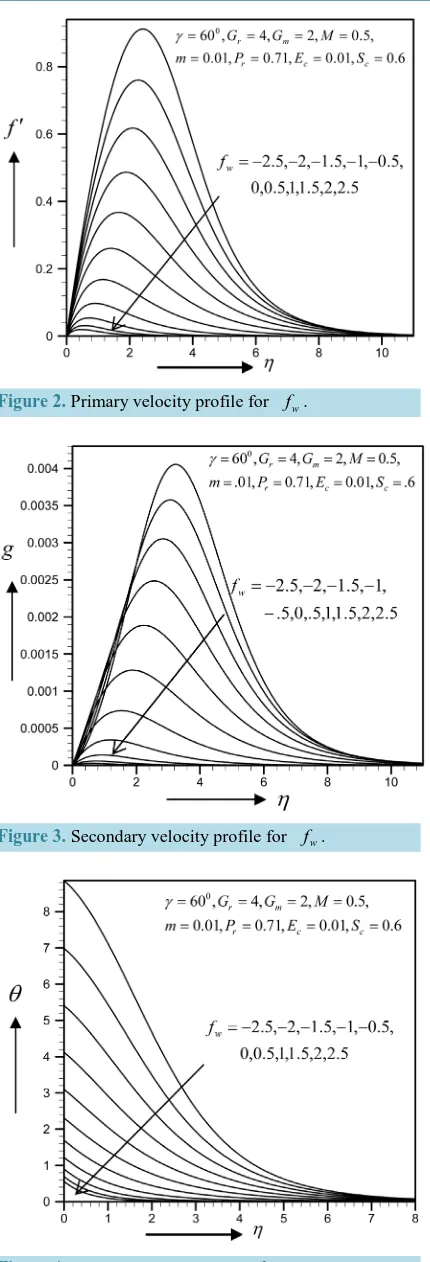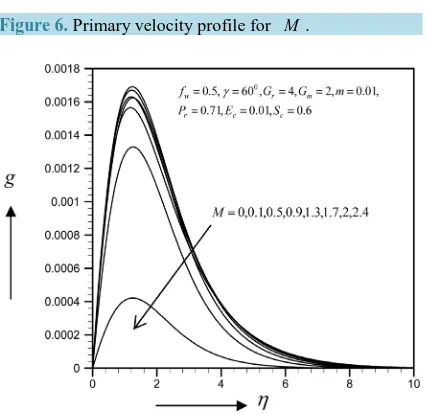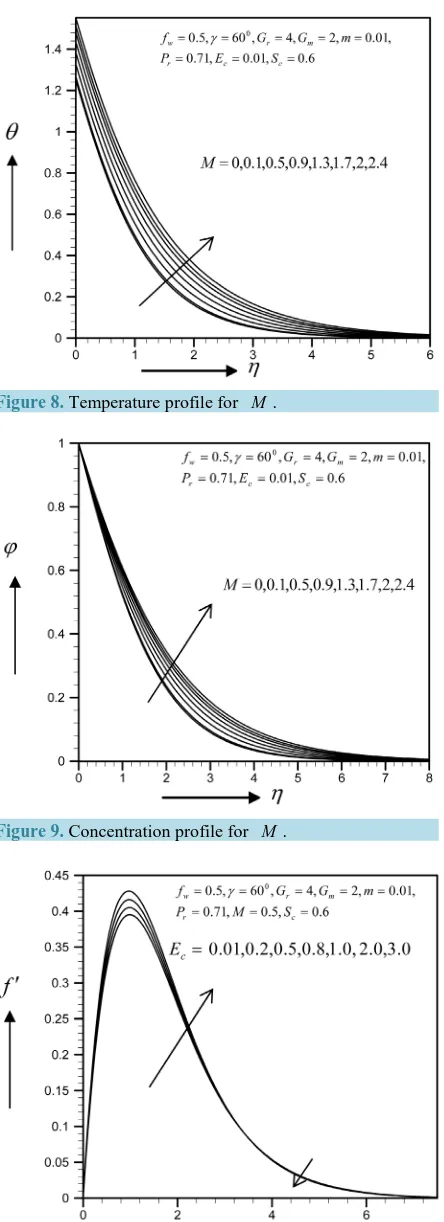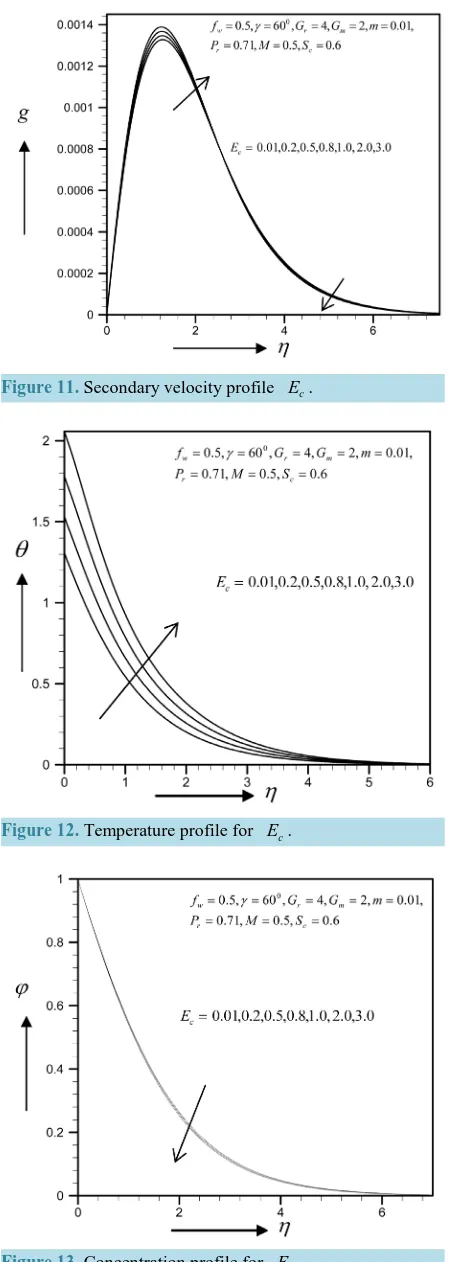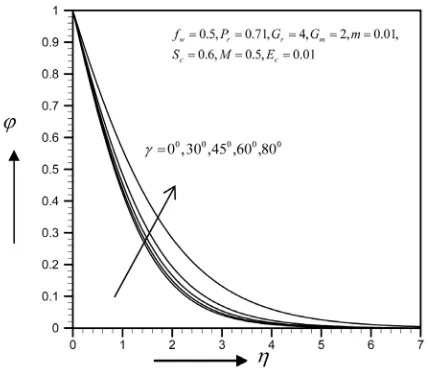http://dx.doi.org/10.4236/jamp.2015.312195
How to cite this paper: Wahiduzzaman, M., Biswas, R., Ali, Md.E., Khan, Md.S. and Karim, I. (2015) Numerical Solution of
Numerical Solution of MHD Convection
and Mass Transfer Flow of Viscous
Incompressible Fluid about an Inclined Plate
with Hall Current and Constant Heat Flux
Mohammad Wahiduzzaman
1, Runu Biswas
2, Md. Eaqub Ali
3, Md. Shakhaoath Khan
4,
Ifsana Karim
41Mathematics Discipline, Khulna University, Khulna, Bangladesh
2Mathematics Open School, Bangladesh Open University, Gazipur, Bangladesh 3Department of Civil Engineering, Sonargaon University, Dhaka, Bangladesh
4Discipline of Chemical Engineering, The University of Newcastle, Callaghan, Australia
Received 14 November 2015; accepted 27 December 2015; published 30 December 2015
Copyright © 2015 by authors and Scientific Research Publishing Inc.
This work is licensed under the Creative Commons Attribution International License (CC BY). http://creativecommons.org/licenses/by/4.0/
Abstract
The present numerically study investigates the influence of the Hall current and constant heat flux on the Magneto hydrodynamic (MHD) natural convection boundary layer viscous incompressible fluid flow in the manifestation of transverse magnetic field near an inclined vertical permeable flat plate. It is assumed that the induced magnetic field is negligible compared with the imposed magnetic field. The governing boundary layer equations have been transferred into non-similar model by implementing similarity approaches. The physical dimensionless parameter has been set up into the model as Prandtl number, Eckert number, Magnetic parameter, Schmidt number, local Grashof number and local modified Grashof number. The numerical method of Nactsheim- Swigert shooting iteration technique together with Runge-Kutta six order iteration scheme has been used to solve the system of governing non-similar equations. The physical effects of the var-ious parameters on dimensionless primary velocity profile, secondary velocity profile, and tem-perature and concentration profile are discussed graphically. Moreover, the local skin friction coefficient, the local Nusselt number and Sherwood number are shown in tabular form for various values of the parameters.
Keywords
1. Introduction
Hall current has important contribution in the study of MHD viscous flows. It has many applications in prob-lems of the Hall accelerators as well as in the flight MHD. The current trend is on the application of MHD to-wards a strong magnetic field and a low density of gas. For this reason, the Hall current and ion slip become important. Hydrodynamic flow of a viscous liquid through a straight channel in presence of Hall Effect is ex-amined by Sato [1], Yamanishi [2], and Sherman and Sutton [3]. The Hall current effects on the boundary layer flow past a semi-infinite plate are studied by Katagiri [4]. Free convection flow of a conducting fluid permeated by a transverse magnetic field in the presence of the Hall effects and uniform magnetic field is analyzed by Pop and Watanabe [5]. Aboeldahab and Elbarbary [6] studied the effect of the Hall current on the MHD free convec-tion flow in the presence of foreign species over a vertical surface, where the flow is subjected to a strong ex-ternal magnetic field. Eichhorn [7] investigated the similarity solution by considering the power-law variations in the plate temperature and transpiration velocity. Vedhanayagam et al. [8] worked on the free convection flow along a vertical plate with the arbitrary blowing and wall temperature. Lin and Yu [9] investigated the free con-vection flow over a horizontal plate. Recently, Hossain et al. [10] investigated the natural convection flow from a vertical permeable flat plate with the variable surface temperature, considering the temperature and transpira-tion rates to follow the power-law variatranspira-tion. Saha et al. [11] studied the effect of Hall current on the steady la-minar natural convection boundary layer flow of MHD viscous and incompressible fluids. Lately, Saha et al. [12]
examined the effect of Hall current on MHD natural convection flow from vertical permeable flat plate with uniform surface heat flux. In recent years a number of studies of MHD convective heat and mass transfer boun-dary layer flow of viscous incompressible fluid were reported in the literature [13]-[25]. However, the effect of hall current and constant heat flux is still not getting promising attraction to the researchers. In this study MHD Free Convection and Mass Transfer Flow of Viscous Incompressible Fluid about an inclined Plate with Hall Current and Constant Heat Flux is investigated.
2. Mathematical Analysis
Steady natural convection boundary layer flow of an electrically conducting and viscous incompressible fluid from a semi-infinite heated permeable inclined flat plate with a uniform surface heat flux and transverse mag-netic field with the effect of the Hall current is considered. Here x axis is taken along the vertically upward di-rection and y axis is normal to it. The leading edge of the permeable surface is taken along z axis. The uniform heat is supplied from the surface of the plate to the fluid, which is maintained uniformly throughout the fluid flow. The temperature and concentration at the wall are Tw and Cw respectively. The temperature and con-centration outside the boundary layer are T∞ and C∞ respectively. Uniform magnetic field of magnitude B0 is imposed to perpendicular to the flow along the y axis. Let the angle of inclination of the plate is
γ
and the plate is semi finite. The x component momentum equation reduces to the boundary layer equation if and only if body force is made by gravity, then the body force per unit mass is Fx= −ρg0cos ,γ where g0 is the accele-ration due to gravity. Further no body force exists in the direction of y and z, i.e. p 0, p 0,
y z
∂ ∂
= =
∂ ∂ and Fy =0,
0
z
F = . The x component of pressure gradient at any point in the boundary layer must equal to the pressure gra-dient in the region outside the boundary layer, in this region u=0, v=0. Hence x component of pressure gra-
dient become p g0cos ,
x
ρ
∞γ
∂ = −
∂ where ρ∞ is the density of the surrounding fluid at temperature T∞. The quantity ρ ρ− ∞ is related to the temperature difference T−T∞ and concentration (or mass) differences
C−C∞ through the thermal volume expansion coefficient
β
and concentration volume expansion coefficientβ∗
by the relation, ρ ρ β
(
T T)
β(
C C)
ρ ∗ ∞ ∞ ∞ − = − − − − , therefore,
(
)
(
)
0 1cos cos .
x p
F g T T g C C
x β γ β γ
ρ ∗ ∞ ∞ ∂ − = − + − ∂
(
)
0 e e
e
J J B E q B
B
ω τ σ µ
+ × = + × (1)
where, µe is the magnetic permeability, τe is the electron collision time, σ is the electrical conductivity,
e
ω is the cyclotron frequency, B0 is the applied magnetic field. Since no applied or polarized voltage exist, so the effect of polarization of fluid is negligible, i.e. E≡
(
0, 0, 0)
.Therefore Equation (1) becomes
(
)
0
.
e e
e
J J B q B
B
ω τ σµ
+ × = × (2)
If is assumed that induced magnetic field generated by fluid motion is negligible in comparison to the applied one i.e. B≡
(
0,B0, 0)
. This assumption is valid because magnetic Reynolds number is very small for liquid metals and partially ionized fluids.Since the Hall coefficient is m=ω τe e, so the Equation (2) we can write
(
)
0 2 1 e z BJ mw u
m
σµ
= +
+ (3)
(
)
0 2 1 e x BJ mu w
m
σµ
= −
+ (4)
where Jy =0. The fundamental equations for the steady incompressible MHD flow with the generalized Ohm’s law and Maxwell’s equations, under the assumptions that the fluid is quasi-neutral, and the ion slip and thermoelectric effects can be neglected. Since the plate is semi-infinite and motion is steady, all physical equa-tions will be the funcequa-tions of x and y. Thus mathematically the problem reduces to a two dimensional problem given as follows:
0
u u
x y
∂ ∂
+ =
∂ ∂ (5)
(
)
(
)
(
)
(
)
2 2 0 02 cos cos 2
1
B
u u u
u g T T g C C u mw
x y y m
σ
ν ν β γ β γ
ρ
∗
∞ ∞
∂ + ∂ = ∂ + − + − − +
∂ ∂ ∂ + (6)
(
)
(
)
2 2 0 2 2 1 Bw w w
u mu w
x y y m
σ
ν ν
ρ
∂ + ∂ = ∂ + −
∂ ∂ ∂ + (7)
2 2
2
2
p p
T T k T u w
u
x y c y c y y
ν ν ρ ∂ ∂ ∂ ∂ ∂ + = + +
∂ ∂ ∂ ∂ ∂ (8)
2. m
C C C
u D
x ν y y
∂ ∂ ∂
+ =
∂ ∂ ∂ (9)
Subjected to the boundary conditions
0, 0, 0, , at 0
0, 0, , as
w
T Q
u v w C C y
y k
u w T T C∞ C∞ y
∂ = = = = − = = ∂ → → → → → ∞ (10)
where u v w, , are the velocity components in the x y z, , direction respectively, υ is the kinematics viscosity,
ρ
is the density. T, Tw and T∞ are the temperature of the fluid inside the thermal boundary layer, the plate temperature and the fluid temperature in the free stream, respectively, while C, Cw, C∞ are the corresponding concentrations. Also, σ is the electric conductivity of the medium, k is the thermal conductivity of the medium,m
D is the coefficient of mass diffusivity, cp is the specific heat at constant pressure, Q is the constant heat flux per unit area and other symbols have their usual meaning.
Figure 1. Physical configuration and co-ordinate system.
adopt the well-defined similarity analysis to attain similarity solutions. For this purpose, the following similarity transformations are now introduced;
0 2 U y x η υ
= , 0
( )
0 w g
U
η = ,
( )
(
)
02 k T T U
Q x θ η υ ∞ − = ,
( ) (
0)
C C C C
φ η ∞
∞ − =
− ,
ψ
= 2υ
xU f0( )
η
u U f0( )
yψ η
∂ ′
∴ = =
∂ and
( )
( )
0
. 2
U
v f f
x x
ν
ψ η η η
∂ ′
= − = −
∂ (11)
Thus, Equations (6)-(10) becomes;
(
)
2
cos cos 0
1
r m
M
f ff G G f mg
m
γθ
γ ϕ
′′′+ ′′+ + − ′+ =
+ (12)
(
)
2 0
1
M
g fg mf g
m
′′+ ′+ ′+ =
+ (13)
( ) ( )
2 2(
)
0
r c r
P E f g P f f
θ′′+ ′′ + ′ − ′θ− θ′ = (14)
0.
c S f
ϕ′′+ ϕ′= (15)
The corresponding boundary conditions are
( )
( )
( )
( )
( )
( )
( )
( )
0, 0, 1
1 at 0
0, 0, 0
0 at
f g
f g
η η θ η
ϕ η η
η η θ η
ϕ η η
′ = = ′ = − = = ′ → → → → → ∞ (16)
where r
p
k P
C
ρ υ
= is the Prandtl number,
3 0 0 2 c p U k E
C Q υxU
= is the Eckert number,
2 0
0
2x B M
U
σ ρ
= is the
Magnetic parameter, c m S
D
υ
= is the Schmidt number, 0
0 0
2
r
g Q x
G
kU U
β ν
= is the local Grashof number,
(
)
* 2 0 2 w mg C C x
G
U
β − ∞
= is the local modified Grashof number. Similarity transformations expressions also
3. Skin-Friction Coefficients, Nusselt Number and Sherwood Number
The quantities of chief physical interest are the skin friction coefficients, the Nusselt number and the Sherwood
number. The equation defining the wall skin frictions are
0 x y u y
τ
µ
= ∂ = ∂ and 0
z y w y
τ
µ
= ∂ = ∂ which are
pro-portional to 2 2 0 f η η = ∂ ∂
and 0
g
η
η
=∂ ∂
. The Nusselt number denoted by Nu is proportional to
0 y T y = ∂ −∂ ,
hence we have Nu∞ −θ′
( )
0 . The Sherwood number denoted by Sh is proportional to0 y C y = ∂ −∂
, hence we
have Sh∞ −ϕ′
( )
0 . The numerical values of the skin-friction coefficients, the Nusselt number and the Sherwood number are sorted in Tables 1-8.4. Results and Discussions
[image:5.595.89.540.297.527.2]In this study the MHD Free Convection and Mass Transfer Flow of Viscous Incompressible Fluid about an
Table 1. Numerical values of Skin friction coefficient τx, τw, Nusselt number Nu and Sherwood Sh for different
values of fw, taking γ =60 , Gr =4, Gm =2, M =0.5, m=0.01, Pr =0.71, Ec=0.01, Sc=0.6 as fixed.
w
f τx τw Nu Sh
−2.5 0.6668289 0.0004485 −8.8553316 0.0084551
−2.0 0.6287051 0.0005869 −6.9865942 0.0178285
−1.5 0.5931507 0.0007727 −5.4077292 0.0368737
−1.0 0.5585643 0.0009901 −4.1194896 0.0741882
−0.5 0.5191494 0.0011747 −3.1007791 0.1427078
0.0 0.4644253 0.0012120 −2.3082940 0.2573300
0.5 0.3853305 0.0010154 −1.6914004 0.4284642
1.0 0.2902217 0.0006616 −1.2231636 0.6558428
1.5 0.2076919 0.0003625 −0.9004500 0.9235492
2.0 0.1512463 0.0001927 −0.6940337 1.2113470
[image:5.595.89.534.538.722.2]2.5 0.1151882 0.0001083 −0.5600067 1.5061140
Table 2. Numerical values of Skin friction coefficient τx,τw, Nusselt number Nu and Sherwood Sh for different values of M, taking fw=0.5, γ =60 ,
4, r
G = Gm=2, m=0.01, Pr =0.71, Ec=0.01, Sc=0.6 as fixed.
M τx τw Nu Sh
0.0 1.1932292 0.0000000 −1.2511745 0.5666003
0.1 1.1505234 0.0006646 −1.2670365 0.5586785
0.5 1.0120026 0.0021178 −1.3286136 0.5313269
0.9 0.9125222 0.0026414 −1.3847014 0.5096192
1.3 0.8378965 0.0028195 −1.4353510 0.4921174
1.7 0.7796588 0.0028587 −1.4811938 0.4777218
2.0 0.7436022 0.0028472 −1.5128227 0.4684503
Table 3. Numerical values of Skin friction coefficient τx, τw, Nusselt number Nu and Sherwood Sh for different values of Ec, taking fw=0.5, γ=60 , Gr =4, Gm =2, m=0.01, Pr=0.71, M =0.5, Sc =0.6 as fixed.
x
τ τw Nu Sh
0.01 1.0092523 0.0021140 −1.3092204 0.5309962
0.2 1.0150838 0.0021221 −1.3503572 0.5316967
0.5 1.0244907 0.0021350 −1.4168547 0.5328213
0.8 1.0341510 0.0021481 −1.4853229 0.5339694
1.0 1.0407378 0.0021571 −1.5321099 0.5347483
2.0 1.0755707 0.0022038 −1.7809118 0.5388165
3.0 1.1139666 0.0022543 −2.0577948 0.5432046
Table 4. Numerical values of Skin friction coefficient τx, τw, Nusselt number Nu and Sherwood Sh for different values of Pr, taking fw=0.5, γ =60 ,
4,
r
G = Gm=2, m=0.01, Sc =0.6, M =0.5, Ec=0.01 as fixed.
r
P τx τw Nu Sh
0.2 3.4971321 0.0054212 −1.8970950 0.7623321
0.5 2.4064302 0.0035968 −1.3401110 0.6562548
0.73 2.0548293 0.0030741 −1.1387300 0.6180418
2.0 1.3704993 0.0022716 −0.6750511 0.5476207
3.0 1.1933258 0.0021228 −0.5234823 0.5329146
4.0 1.0984838 0.0020532 −0.4305351 0.5261758
Table 5. Numerical values of Skin friction coefficient τx, τw, Nusselt number Nu and Sherwood Sh for different values of Sc, taking fw=0.5, γ=60 ,
4, r
G = Gm =2, m=0.01, Pr=0.71, M =0.5, Ec=0.01 as fixed.
c
S τx τw Nu Sh
0.1 2.2727114 0.0046670 −1.0157428 0.2099315
0.5 2.0455986 0.0031604 −1.0939712 0.5470686
0.6 2.0206484 0.0030510 −1.1038032 0.6158846
1.0 1.9525342 0.0028277 −1.1296907 0.8666338
2.0 1.8621742 0.0026558 −1.1585317 1.4158038
3.0 1.8106484 0.0025966 −1.1714276 1.9240325
Table 6. Numerical values of Skin friction coefficient τx, τw, Nusselt number Nu and Sherwood Sh for different values of γ, taking fw=0.5, Gr=4, Gm=2, m=0.01, Pr =0.71, M =0.5, Ec =0.01, Sc =0.6 as fixed.
γ τx τw Nu Sh
0˚ 3.2825601 0.0039806 −0.9686241 0.6969894
30˚ 2.9778622 0.0037784 −0.9941611 0.6795973
45˚ 2.5835102 0.0035011 −1.0328613 0.6551832
60˚ 2.0206484 0.0030510 −1.1038032 0.6158846
Table 7. Numerical values of Skin friction coefficient τx, τw, Nusselt number Nu and Sherwood Sh for different
values of Gr, taking fw=0.5, γ =60 , Pr =0.71, Gm =2, m=0.01, Sc =0.6, M =0.5, Ec=0.01 as fixed.
r
G τx τw Nu Sh
1.0 1.7983003 0.0029964 −1.1233734 0.6084964
2.0 2.0536032 0.0031933 −1.0878147 0.6260093
3.0 2.2878734 0.0033582 −1.0594478 0.6411855
4.0 2.5072444 0.0035082 −1.0357385 0.6544944
5.0 2.7144836 0.0036432 −1.0155186 0.6664838
Table 8. Numerical values of Skin friction coefficient τx, τw, Nusselt number Nu and Sherwood Sh for different
values of Gm, taking fw=0.5, γ=60 , Pr=0.71, Gr=4, m=0.01, Sc=0.6, M =0.5, Ec =0.01 as fixed.
m
G τx τw Nu Sh
1.0 1.7760922 0.0027873 −1.1479420 0.5935038
2.0 2.0206484 0.0030510 −1.1038032 0.6158846
3.0 2.2646066 0.0032880 −1.0670246 0.6361347
4.0 2.5072444 0.0035082 −1.0357385 0.6544944
5.0 2.7474932 0.0037103 −1.0088037 0.6713796
inclined Plate with Hall Current and Constant Heat Flux have been investigated using the Nachtsheim-Swigert shooting iteration technique. To study the physical situation of this problem, we have computed the numerical values of the velocity, temperature, and concentration within the boundary layer and also find the skin friction coefficient, Nusseltnumber, Sherwood number at the plate. It can be seen that the solutions are affected by the parameters, namely suction parameter fw, Grashof number Gr, modified Grashof number Gm, magnetic parameter M, Prandtl number Pr, Eckert number Ec, Schimidt number. The values of M and Gr are taken to be large for cooling Newtonian fluid keeping the plate at different angle. The values 0.2, 0.5, 0.73, 2, 3, 4, 5 are considered for Pr. The values 0.1, 0.5, 0.6, 1.0, 2.0, 3.0, 4.0 also considered for Sc. The values of other parameters are however chosen arbitrarily.
Figures 2-5, respectively, show the primary velocity, secondary velocity, temperature and concentration
Figure 2. Primary velocity profile for fw.
Figure 3. Secondary velocity profile for fw.
Figure 5. Concentration profile for fw.
Figure 6. Primary velocity profile for M.
Figure 8. Temperature profile for M.
Figure 9. Concentration profile for M.
Figure 11. Secondary velocity profile Ec.
Figure 12. Temperature profile for Ec.
[image:11.595.206.421.506.707.2]Figure 14. Primary velocity profile for Sc.
[image:12.595.203.424.185.474.2]Figure 15. Secondary velocity profile for Sc.
[image:12.595.205.424.514.706.2]Figure 17. Concentration profile for Sc.
Figure 18. Primary velocity profile Pr.
Figure 20. Temperature profile for Pr.
[image:14.595.206.424.468.699.2]Figure 21. Concentration profile for Pr.
Figure 23. Secondary velocity profile for γ.
Figure 24. Temperature profile for γ.
Figure 26. Primary velocity profile for Gr.
Figure 27. Secondary velocity profile for Gr.
[image:16.595.204.425.408.694.2]Figure 29. Concentration profile for Gr.
Figure 30. Primary velocity profile for Gm.
[image:17.595.206.423.423.695.2]Figure 32. Temperature profile for Gm.
Figure 33. Concentration profile for Gm.
with the increase of Gm.
From Figure 34-37, show the velocity, secondary velocity, temperature and concentration profile field has a negligible effect for different values of m.
Figure 34. Primary velocity profile for m.
Figure 35. Secondary velocity profile for m.
[image:19.595.208.419.457.695.2]Figure 37. Concentration profile for m.
5. Conclusions
The effect of viscous incompressible fluid flow about an inclined plate with hall current is analyzed in the present study for constant heat flux. A range of physical parameter values tested over the boundary layer flows. The variation of different physical parameters instigated different flow pattern as increasing, decreasing and cross flow in the dimensionless primary and secondary velocity, temperature and concentration distribution as well as in the profile of skin friction coefficients, Nusseltand Sherwood number. The findings of the present in-vestigation are briefly:
• As suction parameter increases, the primary velocity, secondary velocity, temperature and concentration profiles decrease gradually. However for the same parameter effects, the skin friction coefficient decreases and Nusselt and Sherwood numbers increase.
• The primary velocity, secondary velocity profiles as well as the skin friction coefficient, Nusselt and Sher-wood numbers decreased as magnetic parameter increased whereas the reverse effects found in the profile of temperature and concentration.
• The cross-flow of primary and secondary velocity observed as Eckert number increases whereas temperature profile increases and concentration profile decreases for the same parameter effects. Also for the similar pa-rameter effects skin friction coefficient and Sherwood number increase whereas Nusselt number decreases. • The increasing effect of Schmidt number causes primary and secondary velocity profile and concentration
profile as well as the skin friction coefficient and Nusselt number decrease whereas the reverse situation ob-served in the temperature and Sherwood number profiles.
• The cross flow of the primary and secondary velocity with the increase of Prandlt number has been ob-served, where both of the profiles first decrease and near the layer the profiles increase. However within the same parameter effects, the skin friction coefficient and Sherwood number decrease and Nusselt number increases.
• As the parameter
γ
rises the cross flow pattern observed in primary and secondary velocity profiles whe-reas temperature and concentration profile incwhe-rease. However for the same parameter effects the skin friction coefficient, Nusselt number and Sherwood number profiles decrease.• The increasing effect of Grashof and modified Grashof number causes the cross flow of the primary and secondary velocity whereas temperature and concentration profile decrease for the similar parameter effects. However the skin friction coefficient, Nusselt number and Sherwood number increase.
References
Physical Society of Japan, 5, 29.
[3] Sherman, A. and Sutton, G.W. (1961) Magnetohydrodynamics. Evanston, 173-175.
[4] Katagiri, M. (1969) The Effect of Hall Currents on the Viscous Flow Magnetohydrodynamic Boundary Layer Flow
Past a Semi-Infinite Flat Plate. Journal of the Physical Society of Japan, 27, 1051-1059. http://dx.doi.org/10.1143/JPSJ.27.1051
[5] Pop, I. and Watanabe, T. (1994) Hall Effect on Magnetohydrodynamic Free Convection about a Semiinfinite Vertical Flat Plate. International Journal of Engineering Science, 32, 1903-1911.
http://dx.doi.org/10.1016/0020-7225(94)90087-6
[6] Aboeldahab, M.E. and Elbarbary, M.E. (2001) Hall Current Effect on Magnetohydrodynamic Free Convection Flow
Past a Semi-Infinite Plate with Mass Transfer. International Journal of Engineering Science, 39, 1641-1652. http://dx.doi.org/10.1016/S0020-7225(01)00020-9
[7] Eichhorn, R. (1960) The Effect of Mass Transfer on Free Convection. Journal of Heat Transfer, 82, 260-263. http://dx.doi.org/10.1115/1.3679928
[8] Vedhanayagam, M., Altenkirch, R.A. and Echhorn, R.A. (1980) A Transformation of the Boundary Layer Equation for Free Convection Flow Past a Vertical Flat Plate with Arbitrary Blowing and Wall Temperature Variation. International Journal of Heat and Mass Transfer, 23, 1236-1288. http://dx.doi.org/10.1016/0017-9310(80)90059-9
[9] Lin, H.T. and Yu, W.S. (1988) Free Convection on Horizontal Plate with Blowing and Suction. Journal of Heat
Transfer, 110, 793-796. http://dx.doi.org/10.1115/1.3250564
[10] Hossain, M.A., Alam, K.C.A. and Rees, D.A.S. (1997) MHD Free and Forced Convection Boundary Layer Flow along
a Vertical Porous Plate. Applied Mechanics and Engineering, 2, 33-51.
[11] Saha, L.K., Hossain, M.A. and Gorla, R.S.R. (2007) Effect of Hall Current on the MHD Laminar Natural Convection
Flow from a Vertical Permeable Flat Plate with Uniform Surface Temperature. International Journal of Thermal
Sciences, 46, 790-801. http://dx.doi.org/10.1016/j.ijthermalsci.2006.10.009
[12] Saha, L.K., Siddiqa, S. and Hossain, M.A. (2011) Effect of Hall Current on MHD Natural Convection Flow from Ver-tical Permeable Flat Plate with Uniform Surface Heat Flux. Applied Mathematics and Mechanics, 32, 1127-1146. http://dx.doi.org/10.1007/s10483-011-1487-9
[13] Bég, O.A., Khan, M.S., Karim, I., Alam, M.M. and Ferdows, M. (2013) Explicit Numerical Study of Unsteady
Hy-dromagnetic Mixed Convective Nanofluid Flow from an Exponentially Stretching Sheet in Porous Media. Applied
Nanoscience, 4, 943-957. http://dx.doi.org/10.1007/s13204-013-0275-0
[14] Ferdows, M., Khan, M.S., Alam, M.M. and Sun, S. (2012) MHD Mixed Convective Boundary Layer Flow of a
Na-nofluid through a Porous Medium Due to an Exponentially Stretching Sheet. Mathematical Problems in Engineering,
2012, Article ID: 408528. http://dx.doi.org/10.1155/2012/408528
[15] Ferdows, M., Khan, M.S., Bég, O.A. and Alam, M.M (2013) Numerical Study of Transient Magnetohydrodynamic
Radiative Free Convection Nanofluid Flow from a Stretching Permeable Surface. Journal of Process Mechanical En-gineering, 228, 181-196. http://dx.doi.org/10.1177/0954408913493406
[16] Khan, M.S., Karim, I., Islam, M.S. and Wahiduzzaman, M. (2014) MHD Boundary Layer Radiative, Heat Generating
and Chemical Reacting Flow Past a Wedge Moving in a Nanofluid. Nano Convergence, 1, 20. http://dx.doi.org/10.1186/s40580-014-0020-8
[17] Khan, M.S., Alam, M.M. and Ferdows, M. (2013) Effects of Magnetic Field on Radiative Flow of a Nanofluid Past a Stretching Sheet. Procedia Engineering, 56, 316-322. http://dx.doi.org/10.1016/j.proeng.2013.03.125
[18] Khan, M.S., Karim, I., Ali, L.E. and Islam, I. (2012) Unsteady MHD Free Convection Boundary-Layer Flow of a Na-nofluid along a Stretching Sheet with Thermal Radiation and Viscous Dissipation Effects. International Nano Letters,
2, 24. http://dx.doi.org/10.1186/2228-5326-2-24
[19] Khan, M.S., Karim, I. and Biswas, H.A. (2012) Heat Generation, Thermal Radiation and Chemical Reaction Effects on
MHD Mixed Convection Flow over an Unsteady Stretching Permeable Surface. International Journal of Basic and
Applied Science, 1, 363-377.
[20] Khan, M.S., Karim, I. and Biswas, H.A. (2012) Non-Newtonian MHD Mixed Convective Power-Law Fluid Flow over
a Vertical Stretching Sheet with Thermal Radiation, Heat Generation and Chemical Reaction Effects. Academic Re-search International, 3, 80-92.
[21] Khan, M.S., Karim, I. and Islam, M.S. (2014) MHD Buoyancy Flows of Cu, Al2O3 and Tio2Nanofluid near
Stagna-tion-Point on a Vertical Plate with Heat Generation. Physical Science International Journal, 4, 754-767. http://dx.doi.org/10.9734/PSIJ/2014/9074
[22] Khan, M.S., Karim, I. and Islam, M.S. (2014) Possessions of Chemical Reaction on MHD Heat and Mass Transfer
http://dx.doi.org/10.9734/ACSJ/2014/5422
[23] Khan, M.S., Wahiduzzaman, M., Karim, I., Islam, M.S. and Alam, M.M. (2014) Heat Generation Effects on Unsteady Mixed Convection Flow from a Vertical Porous Plate with Induced Magnetic Field. Procedia Engineering, 90, 238-244. http://dx.doi.org/10.1016/j.proeng.2014.11.843
[24] Wahiduzzaman, M., Khan, M.S. and Karim, I. (2015) MHD Convective Stagnation Flow of Nanofluid over a
Shrink-ing Surface with Thermal Radiation, Heat Generation and Chemical Reaction. Procedia Engineering, 105, 398-405. http://dx.doi.org/10.1016/j.proeng.2015.05.025
[25] Wahiduzzaman, M., Khan, M.S., Karim, I., Biswas, P. and Uddin, M.S. (2015) MHD Flow of Fluid over a Rotating
Inclined Permeable Plate with Variable Reactive Index. Physical Science International Journal, 6, 144-162.
Nomenclature
Symbol Name Symbol Name
, ,
x y z Cartesian coordinates Pr Prandtl number
w
f Transpiration parameter Sc Schimidt number
, ,
u v w Velocity components M Magnetic parameter
Q Constant heat flux per unit area Dm Coefficient of mass diffusivity
B Magnetic field intensity cp Specific heat at constant pressure
0
B Constant magnetic field intensity Nu Nusselt number
k Thermal conductivity of the medium Sh Sherwood number
0
g Gravitational acceleration
(
τ τx, z)
Skin-friction coefficientsf′ Non-dimensional primary velocity v0 Suction velocity
g Non-dimensional secondary velocity µ Coefficient of viscosity
0
U Uniform velocity η Similarity variable
T Temperature of the flow field υ Coefficient of kinematics viscosity
w
T Temperature at the plate θ Dimensionless fluid temperature
T∞ Temperature of the fluid outside the boundary layer ϕ Dimensionless fluid concentration
C Species concentration ρ Fluid density
w
C Concentration at the plate σ Electrical conductivity
C∞ Concentration outside the boundary layer β Coefficient of thermal expansion
r
G Grashof number β*
Coefficient of concentration expansion
m

